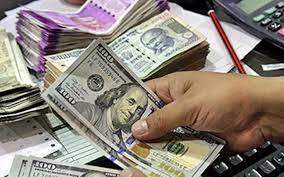
Despite pressures, the rupee’s remarkable resilience-
Despite pressures, the rupee’s remarkable resilience-
Despite pressures, the rupee’s remarkable resilience-
Despite pressures, the rupee’s remarkable resilience--
The Indian rupee has depreciated by around 7% against the U.S. dollar, since the start of the year, in response to various domestic and global factors.
Reason-
Result of geopolitical tensions, ‘a strengthening dollar index, and continuous selloff by foreign portfolio investors have all put pressure on the rupee’.
Safe Haven Demand-
The rate hiking cycle by the US Federal Reserve has precipitated the dollar’s appreciation which has led the dollar index to strengthen by over 11% in 2022 so far, taking it to a 20 year high.
As a result of higher riskfree returns being available in the U.S., there have been persistent out flows of foreign portfolio capital since October 2021, which, on a cumulative basis, stands at $30 billion this year.
This has intensified the downward pressure on the rupee. The safehaven demand for the dollar amid geopolitical risks has bolstered the dollar index.
The Reserve Bank of India (RBI) has stepped in to arrest a large depreciation in the currency, with interventions in the spot and forward foreign exchange markets.
Consequently, India’s foreign exchange reserves have moderated by almost $55 billion from a high of $635 billion seen this year. Elevated global crude oil prices have impinged on India’s oil import bill, in turn widening the trade deficit, thus increasing the demand for U.S. dollars, and affecting forex reserves further.
Notably, even as the rupee has fallen sharply against the dollar, the depreciation has been relatively lower compared with past crises such as the global financial crisis of 2008 (the rupee had weakened by over 20% between December 2007June 2009) and the Taper Tantrum of 2013 (for seven months from the start of the crisis in May 2013, the rupee had depreciated by over 11%). Much of this is attributed to the lowering of India’s external vulnerability measured in terms of a relatively high import cover and low short term external debt. During the Taper Tantrum, India’s import cover stood at over seven months as compared to around 12 months in the current period.
Effects of a weak rupee-
The implications of a weak rupee on the economy are multifold. Among the benefits is the premise that the rupee’s weakening should aid exporters in becoming more competitive. However, the concomitant depreciation of currencies of some of India’s competitors
such as South Korea, Malaysia and Bangladesh against the dollar, along with a high import intensity of some of its key export segments (petroleum, gems and jewellery and electronics), is likely to have blunted the ameliorative impact on India’s exports. Slower global demand is expected to affect outbound shipments as well.
On the flip side, a weaker rupee is driving up prices of key import commodities such as coal, oil, edible oil, gold, thus impacting the imported component of inflation.
The RBI’s measures
Apart from intervening in the Forex market to arrest the fall in the rupee’s value, the RBI announced a slew of measures recently to liberalise foreign inflows into the country and make them more attractive.
Measures such as promoting trade settlements between India and other countries in rupee terms, offering higher interest rates on fresh Foreign Currency Non Resident (Bank) and Non Resident External deposits, a widening of investible universe of government and corporate debt, a relaxation of the interest rate and amount ceiling for External Commercial Borrowing loans, among others, have contributed to arresting the rupee’s slide against the greenback.
Market Bond Index and Barclays Global Bond Index. This will not only lead to forex inflows but also have a benign impact on interest rates. Such measures will keep the forex war chest of the RBI at a comfortable level, providing the central bank the requisite ammunition in case there is further weakness.
The maintenance of the U.S.India interest rate differential along with timely forex market interventions by the central bank to manage volatility will prove to be salutary in preserving the rupee value against the greenback.
